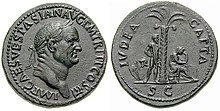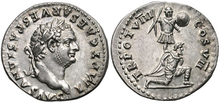Judaea Capta coinage
 From Wikipedia the free encyclopedia
From Wikipedia the free encyclopedia




Judaea Capta coins (also spelled Judea Capta, and, on many of the coins, IVDAEA CAPTA) were a series of commemorative coins originally issued by the Roman Emperor Vespasian to celebrate the capture of Judaea and the destruction of the Second Jewish Temple by his son Titus in 70 CE during the First Jewish Revolt. There are several variants of the coinage. The reverse of the coins may show a female seated right in an attitude of mourning at the base of a palm tree, with either a captive bearded male standing left, with his hands bound behind his back, or the standing figure of the victorious emperor, or the goddess Victoria, with a trophy of weapons, shields, and helmets to the left.
At the bottom of some coins appear the initials SC which stand for "Senatus Consulto", 'by decree of the senate' - the emperor controlled gold and silver coins, and copper alloy coins were controlled by the senate to guarantee their value.[1][2]
Inscription and imagery[edit]
The inscription appears in several versions, IUDAEA CAPTA ("Judaea [has been] conquered"/"conquered Judaea"), in rare cases the harsher IUDAEA DEVICTA or DEVICTA IUDAEA ("Judaea [has been] defeated"/"defeated Judaea"), and also DE IUDAEIS ("[the booty] from the Judaeans") and IUDAEA ("Judaea").[3][4] The inscription may also be in Greek, IOYΔAIAΣ EAΛΩKYIAΣ (Ioudaias Healōkyias),[5] a translation of the Latin IUDAEA CAPTA, or it may sometimes be absent, in which case the assessment on whether the coin belongs to the series is made based on the typical imagery used by the mint.[4]
The palm tree can appear on the coin either in combination with the mourning woman, or without her.[4] Andrea Moresino-Zipper contests that in the former case, it is the woman who symbolises the defeated Judaea and the towering, dominating palm stands for victorious Rome, while in the latter case the palm tree does represent Judaea.[4]
History[edit]
The Judaea Capta coins were struck for 25 years under Vespasian and his two sons who succeeded him as Emperor - Titus and Domitian. These commemorative coins were issued in bronze, silver and gold by mints in Rome, throughout the Roman Empire, and in Judaea itself.[6] They were issued in every denomination, and at least 48 different types are known.[7][8]
Only bronze 'Judaea Capta' coins were struck in Caesarea, in the defeated Roman province of Judea. These coins are much cruder than the Roman issues, and the inscriptions are in Greek rather than Latin. The designs feature the goddess Nike writing on a shield, Minerva with a spear, shield, trophy and palm tree, etc. Most such coins were issued during the reign of the Emperor Domitian (81-96 AD).[6][8]
Unusually, a 'Judaea Capta' coin was also minted by the Jewish ruler Agrippa II, the great-grandson of Herod the Great. Brought up in Rome at the court of Claudius, Agrippa was thoroughly Romanised and was a close friend of Titus, whom he supported throughout the First Jewish Revolt. His bronze coin was minted at Tiberias and shows a portrait of Titus on the obverse with the Greek inscription 'ΚΑΙΣΑΡ ΣΕΒΑΣ ΑΥΤΟΚΡ ΤΙΤΟΣ' (abbreviated for Καῖσαρ Σεβαστὸς Αυτοκράτωρ Τίτος, in Latin: "Caesar Augustus Imperator Titus"), while the reverse depicted the goddess Nike advancing right holding a wreath and palm branch over her shoulder, with a star in upper right field and the inscription 'ETO - KS BA AGRI-PPA'.[citation needed]
See also[edit]
- Arch of Titus
- First Jewish Revolt coinage
- First Jewish–Roman War
- Jewish–Roman wars
- List of historical currencies
- Fall of Masada
- Second Temple
- Siege of Jerusalem
- Temple in Jerusalem
References[edit]
- ^ "How to read a Roman coin, from the Malpas and Knutsford hoards". National Museums Liverpool. Retrieved 2022-04-23.
- ^ "Coin Value: Ancient Rome Coins with S C Annotation 27BC to 376AD". coinquest.com. Retrieved 2022-04-23.
- ^ D. Bernard Hoenig, "The Other Side of the Coin: Israel answers ancient Rome's Judea Capta series with Liberata medals", Biblical Archaeology Review (BAR) 7:2, March/April 1981
- ^ a b c d Andrea Moresino-Zipper (2009). Gerd Theissen; et al. (eds.). Die Judaea-Capta-Münze und das Motiv der Palme. Römisches Siegessymbol oder Repräsentation Judäas? (The Judaea Capta coin and the image of the palm tree: Roman symbol of victory, or representation of Judaea?). Novum Testamentum et Orbis Antiquus/Studien zur Umwelt des Neuen Testaments (NTOA/StUNT) (Book 70) (in German). Göttingen: Vandenhoeck & Ruprecht. pp. 61, 64–67. ISBN 9783525533901. Retrieved 26 July 2018.
{{cite book}}:|work=ignored (help) - ^ Nili Ahipaz, The Coins from Herodium — the Tomb Area (Chapter 10), in Herodium: Final Reports of the 1972–2010 Excavations Directed by Ehud Netzer, Volume I: "Herod's Tomb Precinct", p. 423. Israel Exploration Society, Jerusalem 2015. ISBN 978-965-221-099-9.
- ^ a b Handbook of Biblical Numismatics p.15
- ^ Howard Brin, Judaea Capta Coinage
- ^ a b See "Judaea Capta Coins Sheet - Domitian". Archived from the original on 2010-07-04. Retrieved 2010-07-01.
External links[edit]
- Titus coinage, including Judaea Capta coins
- List of all the Judaea Capta coins with pictures and descriptions
- Vespasian coinage, including Judaea Capta coins
- Domitian coinage, including Judaea Capta coins
- Judaea Capta coins on The Handbook of Biblical Numismatics
- 'Judaea Capta' coins on Jewish History.com
- Gold 'Judaea Capta' coin Archived 2007-12-23 at the Wayback Machine
- 'Judaea Capta' coinage on The Abraham Cowley Text and Image Archive
- 'Judaea Capta' coinage
- "Roman Coins Boast 'Judaea Capta'" Biblical Archaeology Society
- Coinage of the Flavian Dynasty Gallery featuring many 'Judaea Capta' coins